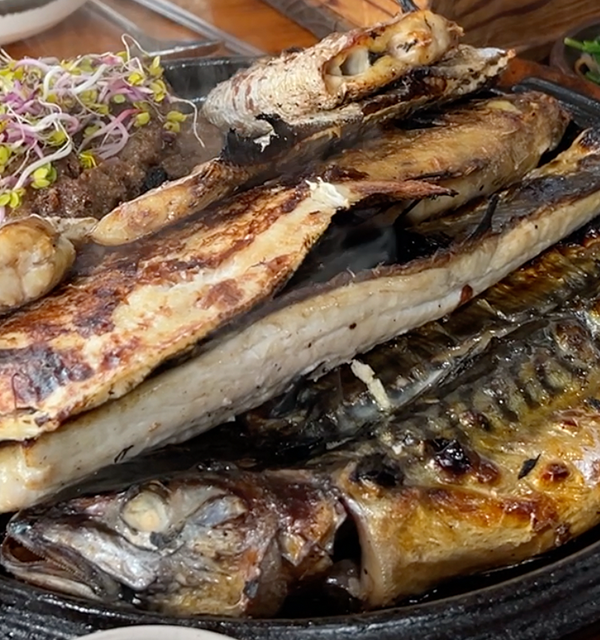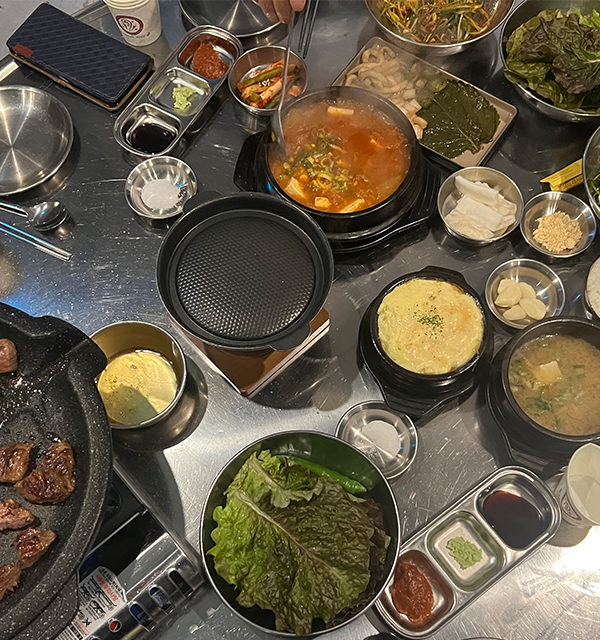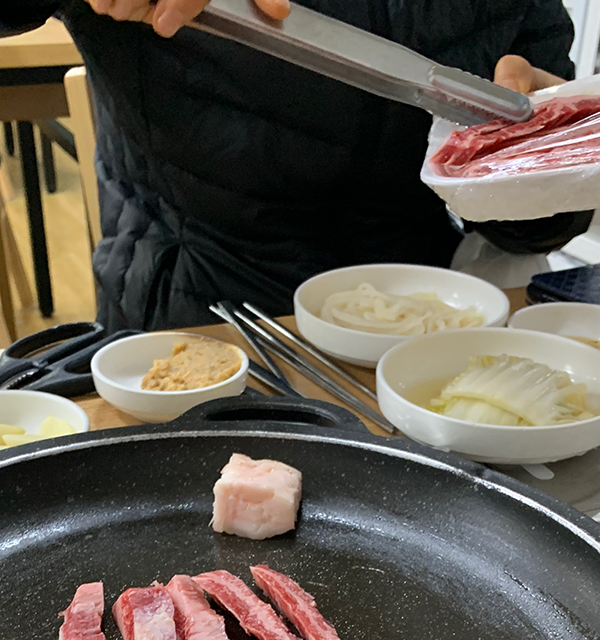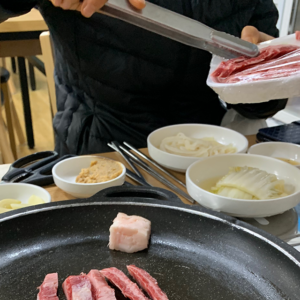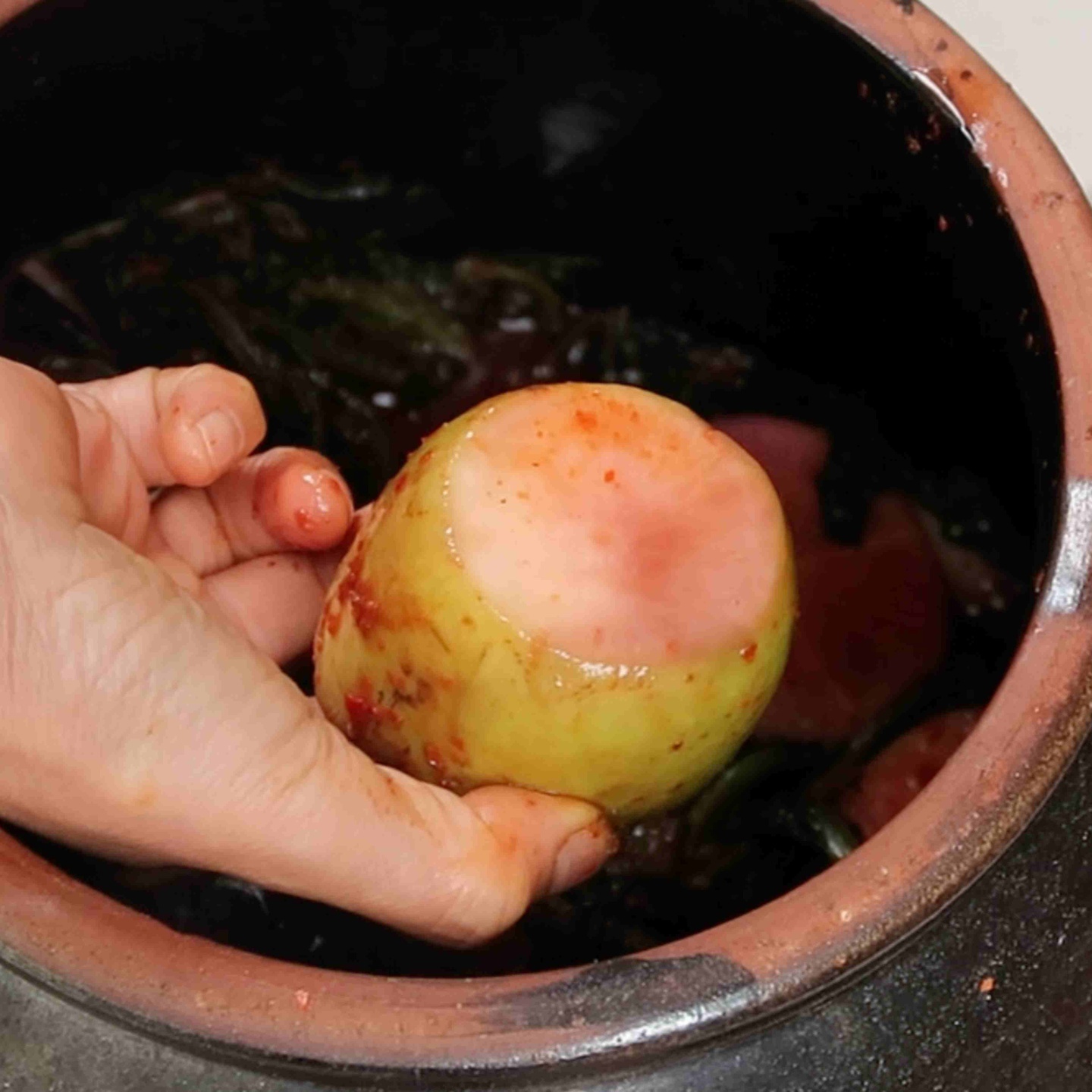There are a lot of proteins that you can use for grilling. They are available in a variety of different thick or thin cuts. You can use the versions that you prefer. There is no real set thickness that is a rule for any of these ingredients.
Grilling Pork
Pork Cuts for Grilling
- Pork Belly (삼겹살): this cut is super popular you guys probably had it already! This cut of meat is high in fat and savory.
- Boston Shoulder (목심): This cut is soft and flavorful. It contains some fat.
- Jowl (항정살): This cut is very soft and contains a lot of fat marbling which gives a savory flavor.
- Pork Back Rib (등겹살): This cut of meat is chewy and tender.
- Tenderloin (안심): This cut has little fat and a soft texture.
- Skirt Meat (갈매기살): This cut of meat is very chewy.
- Loin (등심): This cut is low in fat and has a light, clean flavor. Its texture is very soft.
- Spare Ribs (갈비): This cut is flavorful and juicy because of its fat.
- Pork Skin (돼지껍데기): This cut needs specific preparation before it is used that is not optional. The fat under the skin should be removed, and it should be blanched and marinaded before use to remove any smell and improve the texture. It is super chewy and plush in texture.
- Pork Intestine (돼지곱창): This cut needs special prep as well. The texture is chewy, and the flavor savory.
Basic Pork Grilling Preparations
Depending on the cuts that you plan to use for grilling, for example, intestines or pork skin, you will need to do some extra prep to remove any smell and improve the texture. I will not go into detail about the preparation method for these two cuts because they are less common to grill at home.
When dealing with other pork cuts, you will need to remove the silver skin before using it. The silver skin is the connective tissue on the outside of the meat cut. It makes that part of the meat very tough if you keep it on, so make sure to cut it off. It looks like a silver glare on the skin that you slide your knife under and cut off like a fruit skin. If you have cuts of pork with bones, then you need to soak the cuts in cold water to remove the excess blood and any small bone fragments.
When dealing with cuts of pork like pork belly, you will need to check for and remove any gristle. Gristle is the hard bits on or in the cut of meat that can crack your tooth.
Grilling Beef
Beef Cuts for Grilling
- Brisket (앞다리): This cut is low in fat, tough, and muscular.
- Plate & Flank (양지): These cuts are muscular, tougher, and low in fat. The grain of this cut is easily torn apart when cooked for a long time.
- Rib (갈비): This cut is rich and tender. It can be eaten thinly sliced with the bone intact. There are two different variations of this cut that are often used in Korean grilling: LA Galbi and Galbi. LA Galbi is cut vertically and has several thin pieces of bone in a row. Regular Galbi is cut horizontally with a thick slab of meat attached to one big bone.
- Chuck Eye & Rib Eye (등심): Chuck Eye is flavorful and meaty; it is one of the best cuts for grilling. Rib Eye has a lot of marbling and is soft and tender.
- Tenderloin (안심): This cut is tender and has less fat.
- Sirloin (채끝): This cut has little fat and is decently tender.
- Beef Intestine (소고기곱창): Beef intestines are chewy and require special prep before use.
Grilling Preparations for Beef with Bones
There are some basic preparations needed for beef with bones, for example, ribs (갈비).
Before using beef with bones, soak the cuts in cold water for 30 minutes to remove any blood or beef fragments. Soaking the cuts of beef is also important if you plan to marinade that cut of meat. Removing the blood by soaking helps to prevent marinades from being watered down because if you do not soak the cut, then the blood will release into the marinade and become less concentrated.
Grilling Preparations for Beef without Bones
There are some basic preparations needed for cuts like sliced beef or steak cuts of beef.
Depending on the cut of beef, you may need to remove the silver skin. Silver skin is the connective tissue that is tough and glistens on the meat. It should be cut off, or it will make that part of the meat tough.
After removing any connective tissue or excess fat, you can move on to the next step. The next step is to remove any moisture from the surface of the meat using a paper towel. Making sure the surface is dry makes sure that the beef will brown better once it hits the hot oil in the pan or on the grill.
After ensuring the surface of the meat is dry, you can cure your meat. This is what I like to do because it adds the perfect amount of salty flavor and improves the texture. Curing also removes more excess moisture, which again lets you get a more efficient browning on the surface. We will cover how to cure your proteins later in the chapter.
Grilling Poultry
Chicken Cuts for Grilling
There are other cuts of chicken besides the ones listed below that you can technically grill, like breast or tenderloin. However, I am focusing on the cuts of chicken that work best for this cooking method.
- Drumstick (다리살): This cut has a chewy texture and some fat.
- Thigh (넓적다리): This cut has little fat and a nice umami flavor.
Duck Cuts for Grilling
You can use a lot of different parts of the duck. Some are better than others. Duck breast and leg are my top recommendations, but here are all the parts you can use. You can eat a larger piece of duck or thinly sliced pieces of duck.
- Neck (오리목살): This is the chewiest part of the duck.
- Breast (오리가슴살): This cut is high in protein and has fewer calories compared to other cuts.
- Tenderloin (오리안심): This cut is a soft in texture.
- Wing (오리날개/오리봉): This cut can be grilled but it isn’t the most ideal one.
- Leg (통다리): This cut is chewy in texture.
Grilling Preparations for Poultry
When prepping chicken for grilling, first you want to wash it and then cut off any fatty bits and remove any feathers. Once you are done cleaning the chicken, pat the surface dry with a paper towel. Chicken without bones, like boneless breast, is easier to grill on direct heat in comparison to chicken with bones. You may need to cook chicken with bones at a lower temperature so that you ensure that it is cooked all the way through. Bones or not, make sure you cook your chicken to the correct temperature. Chicken should be cooked to 165F/74C.
When prepping duck for grilling, first wash the duck, then cut off any excess fat that doesn’t cover the meat and remove any feathers. You will want to marinade your duck in some cooking alcohol with ginger to remove any natural odor from the duck. If you are grilling a larger cut of duck, then you may want to score the fat on the duck and grill the piece of duck fat side down to render out some fat and get crispy skin. If you are grilling thinly sliced duck, you can just leave the fat on the edges you do not need to score the fat. Duck should be cooked to 165F/74C.
Grilling Seafood
When pairing grilled sea proteins with a dipping sauce, sesame oil (참기름), wasabi (고추냉이), Ssamjang (쌈장), and Vinegar red pepper sauce (초장) are all great options that pair well with the grilled seafood.
Grilling Shrimp
Shrimp cooks relatively quickly. Once it goes from transparent to white, pink skin, it is ready to eat.
You can grill shrimp directly on your pan or grill. Another option is salt grilling/roasting (소금구이). This method involves adding a bed of coarse salt (천일염) into your pan and heating it before adding your shrimp to the salt and cooking them completely. The benefit of salt roasting your shrimp is that it improves the texture of the shrimp and enhances the natural flavor of the shrimp, giving it a briny, sweet flavor.
You can grill any kind of shrimp that you have. Chinese White Shrimp (대하) is a large popular shrimp to grill in Korea. Shrimp can be grilled with or without the shell. You want to keep the shell on if you are salt roasting the shrimp. In other grilling methods, you can decide to keep it on or off based on your preference.
Aesthetically, you can choose to grill your shrimp whole, butterflied, or cut in half with the shell intact. You can have fun with your plating and display.
Grilling Squid
Before grilling your squid, you need to wash it. Add some coarse salt to your squid and scrub it for a few minutes to clean it, then wash your squid in cold water to clean it further and to remove the excess salt. It is optional to keep on or remove the skin on the squid. The skin is only usually removed for appearance’s sake.
In Korea, squid is usually grilled alone or with a glaze. Cooking squid should not take too long. It can get super tough and chewy if overcooked. A piece of squid should only be grilled for about 5 minutes or less.
Grilling Octopus
Octopus, like squid, also shouldn’t be cooked for too long, or it’ll be tough and chewy. Octopus may be grilled whole or sliced with or without sauce. You can also grill octopus on a skewer with or without the head.
Before grilling your octopus, prep and wash the octopus. First, remove the inside of the octopus head and the beak. After prepping the octopus, you can massage it with coarse salt for a few minutes and then rinse it in fresh cold water to clean it.
Grilling Clams
You want to grill fresh lives clams. It is optional to add butter, onions, fresh pepper, green onion, or garlic to the inside of the clams or on top of the opened clams as they cook.
Depending on the type of clam, you can grill them with the top shell removed or whole.
- Blood Cockles (꼬막), little neck clams (바지락), and black clams (모시조개) are usually grilled whole.
- Pen shells (키조개) and scallops (가리비) usually are grilled with the top shell removed.
Whole Clams:
Before you grill your clams, you need to soak them in salt water to remove the grit and sand in their mouths. Some restaurants that specialize in grilled clams will store their clams in fresh ocean water; this helps to give a good texture and also keeps the clams alive.
When you grill whole clams, they will take 9-10 minutes before they are done.
½ Shelled Clams:
Before your grill your ½-shelled clams, you also need to soak them in salt water to remove any grit. After soaking, wash their shells well in cold water. Then cut open the shell and remove the top shell. Use a knife to scrape the meat free from the bottom shell so that it is easier to eat. Finally, rinse the clam one more time in cold water to remove any foreign pieces, and it is ready to grill.
When you grill 1/2 shelled clams, it will take about 5 minutes.
Grilling Dried Seafood
Whole dried pollock (명품 황태), dried squid, dried herring (과메기), and dried filefish (쥐포) are all popular kinds of dried fish that are grilled. Dried seafood can be grilled in a pan or over an open flame.
- Whole Dried Pollock (명품 황태): When grilling whole dried pollock, you need to prep it first by scrubbing it clean with a food brush. After, you can trim the fins with scissors and remove the spine. This dried fish can be grilled with a sweet glaze before it is cut into pieces and served.
- Dried Squid & Semi Dried Squid (건조오징어/반건조오징어): There are different kinds of dried squid based on how “dried” they are. The main difference between the two is the texture and toughness of the squid. The drier, the tougher it can be to tear it apart with your teeth. You can grill both varieties of these squid over an open flame for a few minutes. Hold your squid with tongs and run it over the flame so that it hits all sections of the squid. Do this on low heat, so you do not burn your squid. After grilling to your preference, you can cut the squid with scissors and eat it with a dipping sauce (soy sauce, sugar, mayo, minced spicy pepper).
- Filefish (쥐포): Grilling dried filefish is very easy. These dried fish are usually already prepped to be grilled and is usually sold in sheets. They have a sweet flavor and are usually grilled over an open flame or in a pan shortly on both sides. Toast these dried fish on low heat until they shrink slightly.
- Dried Herring (과메기): You can buy this dried fish pre-trimmed. If you bought the unprepped version, then trim the tail with scissors and remove the bones inside the fish by peeling off the skin. You can then grill this fish in a pan shortly on both sides before cutting it into bite-sized pieces and serving.
